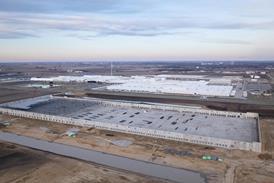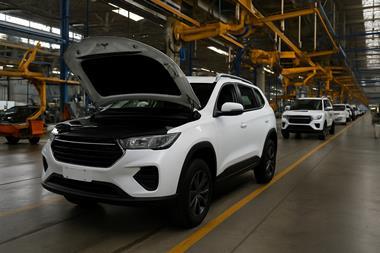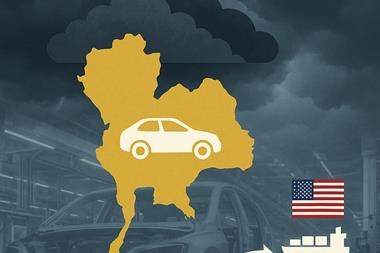Trucking capacity in North America is balanced but still faces strains thanks to driver shortages and changing regulations. Carriers are responding with fleet investments, IT upgrades and a shift to paperless billings.
The number of new vehicle sales in the United States continued to grow in 2012, on pace for an estimated 14.5m units. Predictions for 2013 so far point to moderate increases that could approach 15m units. As volumes recover, OEMs and vehicle logistics providers have been carefully monitoring the need for sufficient truck transport capacity. While the overall consensus seems to be that capacity levels on the road are stable – in a ‘Goldilocks’ state of balance, according to Chrysler (see p10) – there are signs that some regions and brands in North America are already feeling the strain, particularly with a worsening driver shortage and the arrival of stricter federal regulations on hours of service. A growth in production in Mexico, as well as rail wagon shortages, could also have ripple effects for the auto haulier sector.

Filling the void
While investments in new trucking capacity have been made, a top priority among carriers and shippers has been to better use existing capacity by reducing empty miles, which some experts estimate to be around 40% of the total car carrier mileage in North America. Among the approaches to achieving this has been the widespread use of GPS satellites and information technology to increase the velocity and visibility of vehicle deliveries. In other cases, carmakers or terminal managers have been trying to provide a geographically driven release to carriers to help them move full truckloads faster.
The logistics arm of Hyundai and Kia in the US, Glovis America, moves about 50% of the carmakers’ 1.3m annual vehicles by truck and 50% by rail, according to national manager for vehicle logistics, Scott Mize. For imports, the truck-to-rail ratio is 80:20, while 80% of the vehicles produced in the US move by rail.
Mize, who was previously responsible for vehicle logistics at Mazda North America, points out that the trucking industry has changed dramatically during the past few years. Some capacity has been lost following bankruptcies, leading to supply shortages. For Hyundai and Kia, which carry a lower level of vehicle inventory than most OEMs in North America, the lack of capacity has been notable in parts of the country.
“For us, capacity is a regional issue. In the northeast and southeast, where we do not use rail, we need about 10% to 20% more capacity,” s ays Mize. “By contrast, in the midwest and west, it is not a substantial issue.”
However, Mize believes that a shift in production in North America, particularly to the south and to Mexico, will have a knock-on effect for truck capacity. “As the production platform shifts to North America within the next two to five years, more vehicles will be transported to rail stations that are not as near to metropolitan areas as we are accustomed. This will change the dynamics of trucking. Whereas trucks were going to ports for pick-ups, now they will go to railheads that are more remote,” he says.
Mize believes that this change could compound existing problems with communications between truck and rail, as well as dealers. “Less than 5% of our truckers have built their own system, but not at the level that we need for tracking and tracing. The technology is available, but the standard is [one of] minimal communication between carriers and dealers,” says Mize.
He also points to driver shortages that are compounded by poor training programmes. Furthermore, he does not believe that carriers are investing in new equipment at a rate that would match the rise in vehicle sales and production. “Truckers are hesitant of new investments. Instead, they order five or ten units at a time. Although the industry is adding trucks, it is not catching up to the growth rate of carrier demand,” he says.
Barriers to efficiency
Kirk Williams, president and CEO of Jacksonville, Florida-based Proficient Auto Transport, says it tries to eliminate as many empty miles as possible through “triangulations” – finding a load that is in close proximity to the previous load’s drop-off point. “Since capacity has tightened and the cost of new equipment has increased, we need to maximise the utilisation of our existing equipment. We also need to increase our driver productivity,” h e s ays.
For Proficient, more accurate forecasts and plans from customers would help improve productivity. “We are trying to obtain volume and processing projections from our customers that are more accurate,” says Williams. “The problem is there is a high level of inaccuracy from clients – even on the day of the freight tender – and it is not changing.” He hopes that better IT will enable OEMs to place their transport orders electronically, and thus more accurately, although he acknowledges that logistics investment is not always a priority for carmakers.
Mark Rumfola, vice-president of marketing at Hansen and Adkins, which owns 650 trucks, agrees that forecasting shortcomings are a big part of capacity shortages, with much of the crunch coming at the end of financial quarters.
Williams adds that the end-of-month or end-of-quarter rollercoasters are only getting worse, with volume doubling or trebling in those final weeks, only to then “fall off the cliff ”. These swings are putting further strains on capacity, since there are fewer small carriers in the market from which to subcontract. “Prior to the recession, we could call on owner-operators and overflow carriers to ease the peaks, but now most of these companies are gone, as is the elasticity we once enjoyed as an industry,” s ays Williams. “When one carrier is busy, most carriers are also busy and extra capacity is non-existent.”
Another challenge for building truckloads is that, in the post-recession era, dealerships tend to order only one or two cars at a time, says Williams. Thus, Proficient makes an average of three-to-five stops per truck, hindering efficiency.
Some carmakers, vehicle processors or logistics companies, such as Glovis America, have tried to help carriers build loads more efficiently by processing vehicles at ports or distribution centres in order of geographic destinations. This way the carrier can assemble full loads faster, rather than having several cars waiting days to be dispatched just for one or two additional vehicles to fill a truck.
 At Porsche Cars North America, Justin Newell, manager of vehicle logistics and port operations, says it uses only trucks for its vehicle transport, but higher-than expected growth and shortages on rail have eaten into available truck capacity. “There are major capacity issues and driver shortages,” he says. “Furthermore, the upcoming hours of service (HOS) regulations will reduce efficiency.”
At Porsche Cars North America, Justin Newell, manager of vehicle logistics and port operations, says it uses only trucks for its vehicle transport, but higher-than expected growth and shortages on rail have eaten into available truck capacity. “There are major capacity issues and driver shortages,” he says. “Furthermore, the upcoming hours of service (HOS) regulations will reduce efficiency.”
To alleviate shortages, Porsche tries to work with carriers that offer both enclosed and open trailers so that it can achieve more flexibility, particularly at month’s end. “We use open carriers for distances of less than 500 miles (800km), which we pick up and deliver before night, and we use open carriers only for sedans and SUVs.”
Investing in assets and drivers
As well as improving processes, carriers are investing in new equipment and driver training. Proficient, for example, which has seen consistent volume growth of around 35% in 2012 and expects the same next year, is currently investing in new and refurbished trucks. Its current fleet consists of 80 trucks and it plans to increase its this in 2013 by more than 20% – perhaps by as much as 30% – according to Williams.
At Waggoners Trucking, based in Irving, Texas, Scott Goodwin, director of marketing and business development, admits that capacity is constrained. The company has already purchased 60 trucks within the past year and plans to add 100 more in the next several years, according to Goodwin. Waggoners is also trying to use existing equipment as effectively as possible. “In the past, our local terminals made decisions about managing equipment, which did not entail a broad view of our requirements,” he admits. “Now, we have established western, central, and eastern regions. We move equipment within the regions, which helps to minimise shortages.”
 Many carriers point to a lack of qualified drivers as a major contributor to capacity shortages while problems in retention and training are among Waggoners’ most important issues.
Many carriers point to a lack of qualified drivers as a major contributor to capacity shortages while problems in retention and training are among Waggoners’ most important issues.
“Our biggest capacity issue is the need for competent drivers. We need to use our equipment as much as possible,” he says.
At Reliable Carriers, which specialises in moving high-end vehicles such as the Mercedes SLR, Toyota LFA, and Porsche 918, similar challenges exist for its fleet of more than 300 covered trucks. General manager Bob Sellers says it is now advertising for drivers, which it has never done in the past. “Young people do not want to do it. [Car haulier] drivers need to be a bit more skilled than average, which further narrows the field,” says Sellers.
At Proficient Transport, Williams says the company recently initiated an education programme that includes a six-week minimum course and rigorous training.
Federal and dealer restrictions
Many carriers say that the driver situation is set to worsen following planned changes by the Federal Motor Carrier Safety Administration, including stricter regulations on driving hours. “We need a 10% larger fleet in order to deliver the same number of cars. We will have to charge more,” says Sellers, a point echoed by Goodwin. The new regulations are set to take effect in July 2013.
Rumfola says driving restrictions are made more difficult by limited delivery hours at dealerships, most of which don’t accept night or weekend delivery, and some of which run from 8am to just 3pm. “The driver spends the night in the truck and delivers the vehicles in the morning. Unless it is an industry-wide push to extend dealers’ hours, it will not work,” he says. “The rule against night-time deliveries is coming from the dealerships because they are concerned that they would not notice potential damage. Secondly there are security issues for the drivers and the vehicles.”
Rumfola points out that for automotive parts deliveries, many locations already accept goods 24 hours a day.
Mize says that Glovis is working with Hyundai and Kia dealers to extend their hours. “By operating the equipment at nights, we could incorporate two shifts of ten hours in one day,” s ays Mize. “However, the dealerships will not change. It is almost a trust factor between the two. Some dealerships could have had problems with night deliveries in the past and it remains a concern.”
On the other hand, the issue of night deliveries could lie with the trucker. Rumfola admits that Hansen and Adkins has some dealerships it wouldn’t deliver to at night for security reasons. Furthermore, night hours do not help an industry already struggling to attract and retain drivers.
Going paperless
As well as equipment and training, carriers are also making IT investments. Proficient plans to be paperless in 2013 and to provide real-time, instantaneous shipment statuses online.
As part of this process, the company will provide handheld devices for all of its drivers. “This approach takes away some responsibility from the driver,” says Williams. The system automatically generates EDI messages when deliveries or pick-ups are made. If an exception occurs, the driver enters certain codes to send messages as well.
Goodwin says that Waggoners Trucking is also looking at switching to an electronic proof of delivery (ePOD) that would be generated upon dealerships receiving the vehicle, although he does not anticipate using such a system until later in 2013 at the earliest. Currently, Waggoners uses telecommunications technology provider Qualcomm for its GPS tracking. The system also helps with maintenance alerts and fuel mileage efficiency. “We need better communications to minimise dwell time, reduce transit time, and drive waste from the network,” he says. “We are looking at implementing an EPOD system in which the dealership signs for its vehicles, or another platform that is separate from Qualcomm.”

Hansen and Adkins plans to fit all of its cabs with satellites for tracking, hav ing so far completed about 80% of the fleet. “We use PeopleNet for satellite tracking and for our electronic driver log. Hansen and Adkins is also moving toward IT for the OEMs and dealerships by completely redesigning our system in the next six months,” says Rumfola. “It will provide a paperless and real-time environment, that will include load-building and dispatching. For deliveries, if there is damage, the system would photograph it and transmit it electronically.”
Reliable Carriers’ new platform, which was implemented over the past 18 months, will enable its larger clients to interface with its database. All trucks have satellite devices, which provide the status, ETA and information on when the vehicles were delivered. “This has reduced calls by 40%. The upgraded satellite on new units can also do automated logging,” s ays Sellers.
Porsche is switching to ICL Systems by the beginning of 2013, which will provide invoicing, audit payments, collect delivery ETAs and feed them back to obtain cycle times. This will be a change from its previous system, in which the data was not streamed. Porsche also plans to change its vehicle management system worldwide in March, at which time it will use SAP and PeopleSoft Internet Architecture (PIA). The ICL information will be fed into PIA. Porsche currently uses the AS400 platform, which is a challenge to keep market-specific, says Newell.
OEMs look to balance capacity with growth
The rebound in new vehicle volumes has led OEMs to gauge their approach to the new landscape. Dennis Manns, vice-president, sales and logistics planning at American Honda, says flexibility and communication are vital in the current turbulent market. “The interesting part of this type of market is that it forces us to test the norm and to evaluate expenditures closely,” s ays Manns.
Flexibility and good communication have helped Honda’s logistics efficiency. “Presently, we are in a good position with trucking capacity. For midwest destinations, we switched from rail to truck at our Greensburg, Indiana plant in the first quarter [of 2012] due to insufficient rail capacity. We expanded the trucking zone from 300 miles to between 400 and 450 miles,” says Manns.
As it continued to grow strongly in North America, Dr. Ansgar Hermes, senior manager transportation, says Vo l k s w agen adjusted its road transport network in early 2012 to accommodate its growth. “We organised our network in order to accommodate our growth and we have implemented a capacity management process that helps our carriers and service providers adjust to our needs. If a carrier experiences a capacity shortage, we encourage it to let us know early so that, together, we can provide sustainable service to our dealerships,” he says.
 Vo l k s w agen aims for a mix of large and smaller carriers to meet its needs. Hermes wants large carriers that offer both capacity and flexibility, and small carriers strong in specific regions that can provide dedicated trucks.
Vo l k s w agen aims for a mix of large and smaller carriers to meet its needs. Hermes wants large carriers that offer both capacity and flexibility, and small carriers strong in specific regions that can provide dedicated trucks.
Hermes adds that the company is looking to adjust contracts with carriers based on its growing volume requirements. “Since some of our trucking contracts will expire soon, we are looking more closely at the service and capacity that our potential carriers would provide,” says Hermes. “Our approach includes right-sizing a carrier’s service area for us as a means of adjusting it to its capabilities.”
Vo l k s w agen is currently working on enhancing its prioritisation capabilities for sold cars as well as its ETA prediction capabilities. In March 2012, the Volkswagen Group also announced its goal to make production 25% more environmentally friendly, which Hermes says includes reducing emissions in road transport.
While there is a risk of further road capacity shortages in North America, the industry has been able to mitigate shortfalls by looking for more backhaul opportunities. As this potential is far from limitless, technology advances such as paperless deliveries, as well as cooperation with other supply chain partners on processes such as geographic-based load building, are steps in the right direction.
None of these approaches have arguably been implemented quickly enough, but since new vehicle sales are expected to grow more slowly in 2013 than 2012, it may allow more time for carriers and OEMs to make improvements – especially before a host of new production plants come online in Mexico in subsequent years and radically change vehicle flows for many OEMs.





































